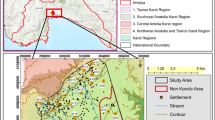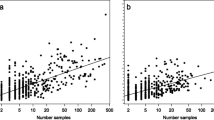Abstract
The groundwater in headwater region is an important recharge source for the adjacent mountain-front plain. In order to reveal the relationship among precipitation, soil water and groundwater, from June to September in 2004, stable isotopes (deuterium and oxygen-18) in precipitation and soil waters at the depths of 10, 20, 30, 50, 70, 90, and 110 cm were analyzed at two sites covered by black locust (Robinia Pseudoacia L.) (Site A) and grass predominated by Themeda triandra (T. japonica (Willd.) Tanaka) and Bothriochloa ischaemum (B. ischaemum (L.) Keng) (Site B) in an experimental catchment at Taihang Mt., North China, respectively. The δ18O of precipitation in daily rain events shows large variations (−13.3 to −4.3‰) with a mean of 8.1‰. The δ18O and δ D of soil waters along profiles in two sites suggest that the influence of canopy cover was just up to 10 cm in top soil water. The soil water moved over the zero flux plane at 70 cm in-depth is expected to escape the evaporative effect at the end of September in both sites. The results show that the stable isotope, instead of tritium as tradition, can be used to trace the soil water behaviors based on the movement of isotopic peak along the vertical profiles in this semi-arid and semi-humid mountainous region. The infiltration depths of soil water in Taihang Mt. are 12 and 10 mm/day from June to September in 2004 in Site A and Site B, respectively. Tracing by stable isotope, recharge fluxes of soil water to local groundwater are of 3.8 and 3.2 mm/day in Site A and Site B, respectively. The results provide desirable information for assessment of local groundwater resources.











Similar content being viewed by others
References
Allison GB, Barnes CJ (1983) Estimation of evaporation from non-vegetated surfaces using natural deuterium. Nature 301:143–145
Allison GB, Hughes MW (1972) Comparison of recharge to groundwater under pasture and forest using environmental tritium. J Hydrol 17:81–95
Allison GB, Barnes CJ, Hughes MW, Leaney FWJ (1984) The effect of climate and vegetation on oxygen-18 and deuterium profiles in soils Isotope Hydrology 1983. In: Proceedings of the Symposium IAEA, Vienna, pp 105–123
Barnes CJ, Allison GB (1983) The distribution of deuterium and 18O in dry soils: 1. Theory. J Hydrol 60:141–156
Barnes CJ, Allison GB (1984) The distribution of deuterium and 18O in dry soils: 3. Theory for non-isothermal water movement. J Hydrol 74:119–135
Barnes CJ, Walker GR (1989) The distribution of deuterium and oxygen-18 during unsteady evaporation from a dry soil. J Hydrol 112:55–67
Bengtsson L, Saxena RK, Dressie Z (1987) Soil water movement estimated from isotope tracers. Hydrol Sci J 32:497–520
Bristow KL, Horton R (1996) Modeling the impact of partial surface mulch on soil heat and water flow. Theor Appl Climatol 54:85–98
Brodersen C, Pohl S, Lindenlaub M, Leibundgut C, Wilpert KV (2000) Influence of vegetation structure on isotope content of throughfall and soil water. Hydrol Processes 14:1439–1448
Chung S-O, Horton R (1987) Soil heat and water flow with a partial surface mulch. Water Resour Res 23:2175–2186
Craig H (1961) Isotopic variations in meteoric waters. Science 133:1702–1703
Gazis C, Feng X (2004) A stable isotope study of soil water: evidence for mixing and preferential flow paths. Geoderma 119:97–111
Gehrels JC, Peeters JEM, De Vries JJ, Dekkers M (1998) Mechanism of soil water movement as inferred from 18O stable isotope studies. Hydrol Sci J 43:579–594
Hsieh JCC, Chadwick OA, Kelly EF, Savin SM (1998) Oxygen isotopic composition of soil water: quantifying evaporation and transpiration. Geoderma 82:269–293
Knowlton RG Jr, Parsons AM, Gaither KN (1992) Techniques for quantifying the recharge rate through unsaturated soils ASTM Special Technical Publication. ASTM, Philadelphia, pp 111–123
Lin R, Wei K (2006) Tritium profiles of pore water in the Chinese loess unsaturated zone: implications for estimation of groundwater recharge. J Hydrol 328:192–199
Liu CM, He XW (1996) Strategies for water problems in the 21st century in China. Scientific Press, Beijing
Liu B, Phillips F, Hoines S, Campbell AR, Sharma P (1995) Water movement in desert soil traced by hydrogen and oxygen isotopes, chloride, and chlorine-36, southern Arizona. J Hydrol 168:91–110
Liu C, Yu J, Kendy E (2001) Groundwater exploitation and its impact on the environment in the North China Plain. Water Int 26:265–272
Mathieu R, Bariac T (1996) An isotopic study (2H and 18O) of water movements in clayey soils under a semiarid climate. Water Resour Res 32:779–789
Midwood AJ, Boutton TW, Watts SE, Archer SR (1993) Natural abundance of 2H and 18O in rainfall, soil moisture and plants in a subtropical thorn woodland ecosystem: implications for plant water use. International Atomic Energy Agency, Proceedings Series. IAEA, Vienna, pp 419–431
Newman BD, Campbell AR, Wilcox BP (1997) Tracer-based studies of soil water movement in semi-arid forests of New Mexico. J Hydrol 196:251–270
Saxena RK, Dressie Z (1984) Estimation of groundwater recharge and moisture movement in sandy formations by tracing natural oxygen-18 and injected tritium profiles in the unsaturated zone. In: Proceedings of the symposium on isotope hydrology in water resource development, IAEA, Vienna, pp 139–150
Shurbaji ARM, Phillips FM (1995) A numerical model for the movement of H2O, H 182 O, and 2HHO in the unsaturated zone. J Hydrol 171:125–142
Swistock BR, Dewalle DR, Sharpe WE (1989) Sources of acidic storm flow in an Appalachian headwater stream. Water Resour Res 25:2139–2147
Tang C, Chen J, Shindo S, Sakura Y, Zhang W, Shen Y (2004) Assessment of groundwater contamination by nitrates associated with wastewater irrigation: a case study in Shijiazhuang region, China. Hydrol Processes 18:2303–2312
Walker GR, Hughes MW, Allison GB, Barnes CJ (1988) The movement of isotopes of water during evaporation from a bare soil surface. J Hydrol 97:181–197
Yang Y, Watanabe M, Sakura Y, Tang C, Hayashi S (2002) Groundwater-table and recharge changes in the Piedmont region of Taihang Mountain in Gaocheng City and its relation to agricultural water use. Water SA 28:171–178
Zhang Q, Li F, Ou G, Song X, Zhang W (2005) Response of soil moisture variation to precipitation and mulching measures. J Beijing For Univ 27:37–41
Zimmermann U, Münnich KO, Roether W (1966) Tracers determine movement of soil moisture and evapotranspiration. Science 152:346–347
Zimmermann U, Ehhalt DH, Münnich KO (1967a) Soil water movement and evapotranspiration: changes in the isotopic composition of the water. In: Proceedings of the IAEA symposium on the use of isotopes in hydrology. IAEA, Vienna, 1966, pp 567–584
Zimmermann U, Münnich KO, Roether W (1967b) Downward movement of soil moisture traced by means of hydrogen isotopes. Isotope techniques in the hydrologic cycle. Am Geophys Union Geophys Monogr Ser 11:28–36
Acknowledgments
This work was supported by the National Natural Sciences Foundation of China (no. 40671034), the Knowledge Innovation Programs from Chinese Academy of Sciences (KZCX3-SW-446), and Grant-in-Aid for Scientific Research of Japan Society for the Promotion of Science (no. 18300312). The authors thank Roberto Gonfiantini for his thoughtful review and comments.
Author information
Authors and Affiliations
Corresponding author
Additional information
An erratum to this article can be found at http://dx.doi.org/10.1007/s00254-007-0744-4
Rights and permissions
About this article
Cite this article
Li, F., Song, X., Tang, C. et al. Tracing infiltration and recharge using stable isotope in Taihang Mt., North China. Environ Geol 53, 687–696 (2007). https://doi.org/10.1007/s00254-007-0683-0
Received:
Accepted:
Published:
Issue Date:
DOI: https://doi.org/10.1007/s00254-007-0683-0




